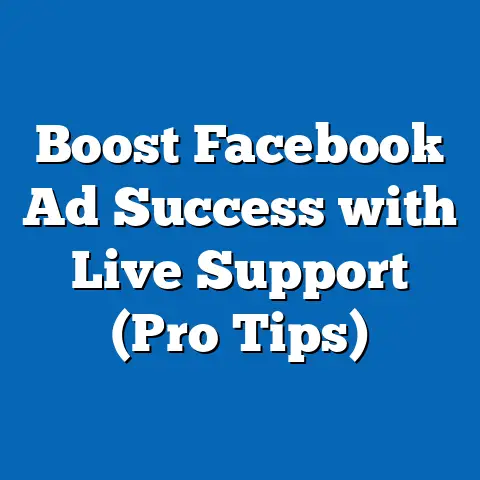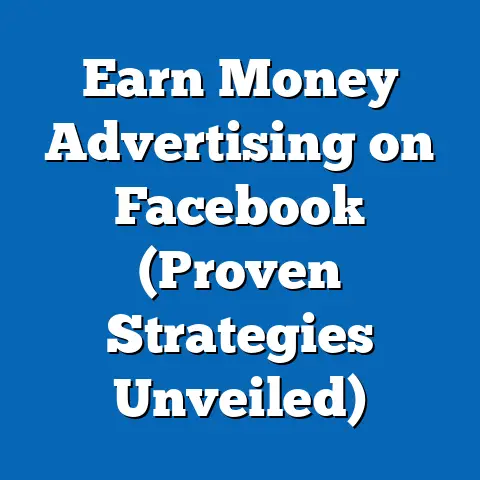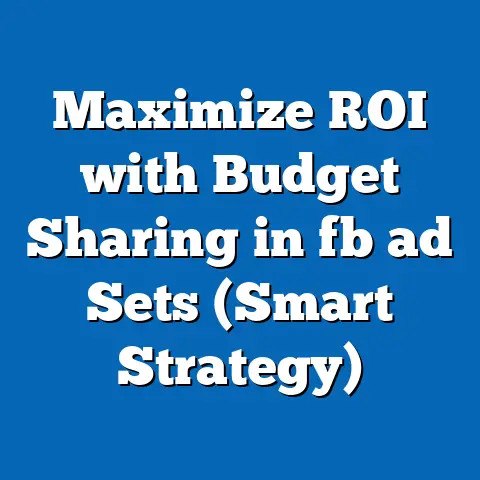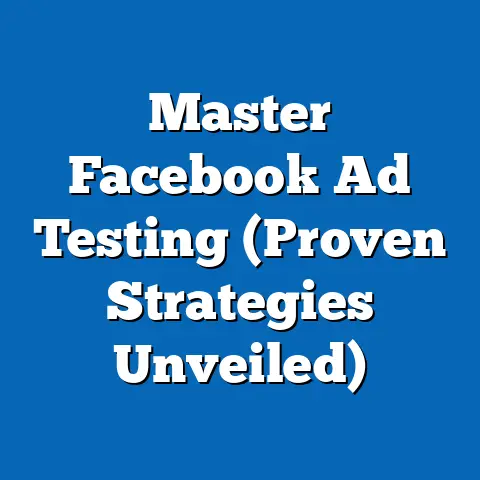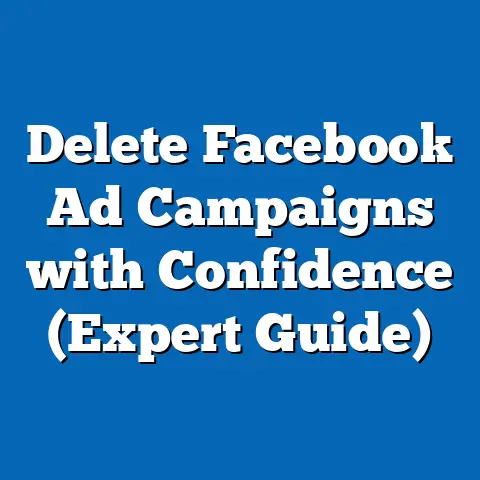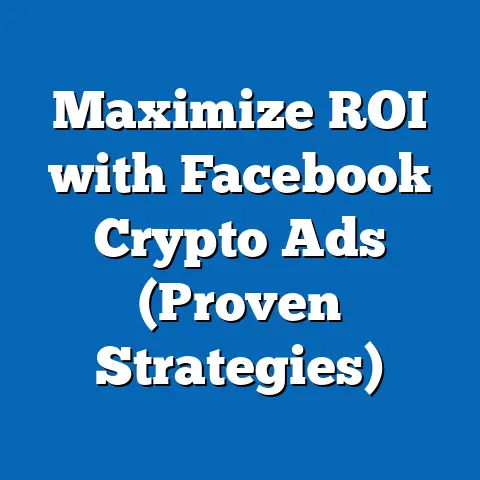Master Video fb ad Specs (Essential Guidelines Unveiled)
The digital battlefield is fierce. Every day, businesses wage war for the fleeting attention of consumers scrolling through their Facebook feeds. Billions of dollars are poured into advertising, yet only a fraction truly breaks through the noise. In this cutthroat arena, video content has emerged as the undisputed champion, a dynamic force capable of captivating audiences and driving unprecedented engagement. But simply creating a video isn’t enough. To truly conquer the Facebook advertising landscape, you need to understand the intricate, often-overlooked specifications that govern video ads. Mastering these specs isn’t just about compliance; it’s about unlocking the full potential of your video marketing efforts and ensuring your message resonates with maximum impact. I’ve seen countless businesses stumble, creating visually stunning videos that simply don’t perform because they ignored the fundamental rules of the game. This guide will arm you with the knowledge to avoid those pitfalls and create video ads that truly shine.
The Power of Video Ads
Let’s be honest: who wants to read a wall of text when they can watch a captivating video? I know I don’t! And that’s precisely why video marketing has become such a dominant force on Facebook. The numbers speak for themselves. According to recent studies, video ads enjoy significantly higher engagement rates than static images or text-based posts. Viewers are more likely to stop scrolling, watch the video, and even share it with their friends.
But it’s not just about engagement; it’s about conversions. A well-crafted video can tell a story, evoke emotions, and build trust with your audience in a way that other formats simply can’t match. Consider Dollar Shave Club’s viral video from back in 2012. It was low-budget, quirky, and hilarious, but it perfectly captured the brand’s personality and value proposition. The result? Overnight success and a complete disruption of the shaving industry.
I’ve personally witnessed the power of video ads in my own campaigns. For a local restaurant client, we shifted from static image ads to short, mouth-watering videos showcasing their signature dishes. The impact was immediate: website traffic doubled, online orders skyrocketed, and the restaurant saw a noticeable increase in foot traffic.
Video ads offer a unique opportunity to connect with your audience on a deeper level. They allow you to showcase your brand’s personality, highlight your product’s features, and create a lasting impression. In a world saturated with information, video helps you cut through the clutter and capture the attention of your target audience.
Takeaway: Video ads are not just a trend; they’re a fundamental component of successful Facebook marketing. They offer unparalleled engagement, conversion potential, and the ability to connect with your audience on an emotional level.
Understanding Facebook Video Ad Specs
Now that we’ve established the power of video ads, let’s dive into the nitty-gritty details: the technical specifications. This is where many marketers get tripped up, but understanding these specs is crucial for ensuring your videos look their best and perform optimally across all devices.
Video Formats
Facebook supports a variety of video formats, each with its own unique characteristics and ideal use cases. Here’s a breakdown of the most common formats:
- Feed Ads: These are the standard video ads that appear directly in users’ news feeds. They’re highly versatile and can be used for a wide range of marketing objectives, from brand awareness to lead generation. I’ve found that shorter, attention-grabbing videos work best in the feed, as users are often scrolling quickly.
- Stories Ads: Stories ads are short, vertical videos that appear between users’ Stories. They’re perfect for capturing attention in a visually engaging way and are particularly effective for reaching younger audiences. Remember, Stories are designed for quick consumption, so keep your message concise and visually appealing.
- In-Stream Ads: These are video ads that play before, during, or after other video content on Facebook. They’re a great way to reach a highly engaged audience, but it’s important to create ads that are relevant to the content they’re playing alongside. I’ve seen success with ads that offer value or entertainment, rather than simply being interruptive.
- Instant Articles Ads: These ads appear within Facebook’s Instant Articles, which are designed to load quickly and provide a seamless reading experience. They’re a good option for reaching users who are actively consuming content on Facebook.
- Right Column Ads: These are smaller video ads that appear in the right column of Facebook’s desktop site. They’re less visually prominent than other formats, but they can still be effective for reaching users who are browsing Facebook on their computers.
Resolution and Aspect Ratios
The resolution and aspect ratio of your video ads are critical for ensuring they look their best across all devices. Here are some recommended guidelines:
- Resolution: Aim for a minimum resolution of 1080 x 1080 pixels for square videos and 1920 x 1080 pixels for horizontal videos. This will ensure your videos look sharp and clear on high-resolution screens. I always advise my clients to err on the side of higher resolution, as it’s better to have a video that looks great than one that looks pixelated.
- Aspect Ratios: Facebook supports a variety of aspect ratios, but the most common are 1:1 (square), 9:16 (vertical), and 16:9 (horizontal). Square videos are ideal for mobile viewing, as they take up more screen real estate. Vertical videos are perfect for Stories ads, while horizontal videos are well-suited for feed ads and in-stream ads. I’ve found that testing different aspect ratios can significantly impact ad performance, so don’t be afraid to experiment.
File Size and Length
Facebook also imposes limitations on the file size and length of video ads. Here’s what you need to know:
- File Size: The maximum file size for video ads is 4GB. However, I recommend keeping your file size as small as possible to ensure fast loading times. Large files can lead to buffering issues and frustrated viewers, which can negatively impact your ad performance.
- Length: The ideal length of your video ad will depend on the format and your marketing objectives. For feed ads, I recommend keeping your videos under 15 seconds to capture attention quickly. Stories ads should be even shorter, ideally around 5-7 seconds. In-stream ads can be longer, but it’s still important to keep them concise and engaging. Remember, attention spans are short, so make every second count.
Captions and Text Guidelines
Captions are essential for making your video ads accessible to a wider audience, especially those who watch videos with the sound off. According to Facebook, 80% of users watch videos with the sound muted, so captions are no longer optional; they’re a necessity.
- Captions: I recommend adding captions to all of your video ads, regardless of the format. You can either upload a separate SRT file or use Facebook’s built-in captioning tool. Make sure your captions are accurate and easy to read.
- Text Guidelines: Facebook also has guidelines for the amount of text that can appear in your video ad’s thumbnail. The general rule is that text should not occupy more than 20% of the thumbnail. This is to ensure that your ads are visually appealing and don’t appear cluttered. I’ve found that ads with minimal text in the thumbnail tend to perform better, as they’re more likely to capture attention.
Takeaway: Understanding Facebook’s video ad specs is crucial for ensuring your videos look their best and perform optimally across all devices. Pay close attention to video formats, resolution, aspect ratios, file size, length, captions, and text guidelines.
Crafting Compelling Video Content
While technical specs are important, they’re only half the battle. The other half is crafting compelling video content that resonates with your target audience. This is where your creativity comes into play.
Storytelling Techniques
The best video ads tell a story. They don’t just showcase your product’s features; they create a narrative that connects with your audience on an emotional level. Consider Dove’s “Real Beauty” campaign, which challenged traditional beauty standards and celebrated the diversity of women. The campaign was a huge success because it tapped into a powerful emotional truth and resonated with millions of women around the world.
- Identify Your Audience’s Pain Points: What are their biggest challenges and frustrations? How can your product or service help them overcome these challenges?
- Create a Narrative Arc: Every good story has a beginning, middle, and end. Start by introducing the problem, then showcase your solution, and finally, highlight the benefits of using your product or service.
- Use Emotion to Connect: Emotion is a powerful tool for creating a lasting impression. Whether it’s humor, inspiration, or empathy, use emotion to connect with your audience on a deeper level.
- Keep it Concise: Remember, attention spans are short, so get to the point quickly. Focus on telling a compelling story in a concise and engaging way.
Branding Elements
Your video ads should always reinforce your brand identity. This means incorporating your logo, colors, and themes effectively.
- Logo Placement: Make sure your logo is visible throughout the video, but don’t make it too intrusive. A subtle logo in the corner of the screen is usually sufficient.
- Color Palette: Use colors that are consistent with your brand’s visual identity. This will help reinforce brand recognition and create a cohesive look and feel.
- Themes: Choose themes that are relevant to your brand and your target audience. This will help create a stronger connection with your viewers and make your ads more memorable.
Call to Action (CTA)
A strong call to action is essential for driving conversions. Tell viewers exactly what you want them to do, whether it’s visiting your website, making a purchase, or signing up for your email list.
- Be Clear and Concise: Your CTA should be clear and easy to understand. Use action-oriented language, such as “Shop Now,” “Learn More,” or “Sign Up Today.”
- Make it Prominent: Your CTA should be visually prominent and easy to click or tap. Use a contrasting color and a clear font.
- Create a Sense of Urgency: Create a sense of urgency by using phrases like “Limited Time Offer” or “While Supplies Last.” This will encourage viewers to take action immediately.
Audience Targeting
Knowing your audience is crucial for creating effective video ads. The more you know about your target audience, the better you can tailor your content to meet their preferences and pain points.
- Demographics: Target your ads based on age, gender, location, education, and other demographic factors.
- Interests: Target your ads based on users’ interests, hobbies, and activities.
- Behaviors: Target your ads based on users’ online behaviors, such as their purchase history, website visits, and Facebook activity.
- Custom Audiences: Create custom audiences based on your existing customer data, such as email lists and website visitors.
- Lookalike Audiences: Create lookalike audiences based on your existing customer data. This will allow you to reach new users who are similar to your best customers.
Takeaway: Crafting compelling video content is just as important as understanding technical specs. Focus on telling a story, reinforcing your brand identity, using a strong call to action, and targeting your ads to the right audience.
Best Practices for Facebook Video Ads
Now that you have a solid understanding of video ad specs and content creation, let’s discuss some best practices for maximizing your results.
Testing and Optimization
A/B testing is essential for optimizing your video ads. Test different elements, such as thumbnails, headlines, ad copy, and CTAs, to see what resonates best with your audience.
- Thumbnails: Test different thumbnails to see which ones capture the most attention. Use high-quality images that are visually appealing and relevant to your video content.
- Headlines: Test different headlines to see which ones generate the most clicks. Use compelling language that grabs attention and encourages viewers to watch your video.
- Ad Copy: Test different ad copy to see which ones resonate best with your audience. Use clear and concise language that highlights the benefits of your product or service.
- CTAs: Test different CTAs to see which ones drive the most conversions. Use action-oriented language that encourages viewers to take the desired action.
Analytics and Performance Tracking
Tracking your ad performance is crucial for gauging effectiveness and making adjustments as needed. Facebook Ads Manager provides a wealth of data, including impressions, reach, engagement, and conversions.
- Impressions: The number of times your ad was displayed.
- Reach: The number of unique users who saw your ad.
- Engagement: The number of likes, comments, shares, and clicks your ad received.
- Conversions: The number of users who took the desired action, such as visiting your website, making a purchase, or signing up for your email list.
Keeping Up with Trends
The world of video advertising is constantly evolving, so it’s important to stay updated on the latest trends and adapt your strategies accordingly.
- Follow Industry Blogs and Publications: Stay informed about the latest trends and best practices by following industry blogs and publications.
- Attend Industry Events: Network with other marketers and learn about the latest innovations at industry events.
- Experiment with New Formats: Don’t be afraid to experiment with new video formats and features as they become available.
Takeaway: Best practices for Facebook video ads include testing and optimization, analytics and performance tracking, and keeping up with trends.
Conclusion
Mastering Facebook video ad specs is not just about adhering to guidelines; it’s about unlocking the full potential of video advertising and maximizing your ROI. By understanding the technical specifications, crafting compelling content, and following best practices, you can create video ads that capture attention, engage your audience, and drive conversions.
In the competitive landscape of social media advertising, every detail counts. Don’t let your videos get lost in the noise. Take the time to understand Facebook’s video ad specs and create videos that shine.
Call to Action: Now that you’re armed with this knowledge, take a critical look at your current video ad strategies. Are you adhering to Facebook’s specs? Are you crafting compelling content that resonates with your audience? Are you tracking your performance and making adjustments as needed? The answers to these questions will determine your success in the battle for consumer attention. Start analyzing, start optimizing, and get ready to launch your next successful campaign!

